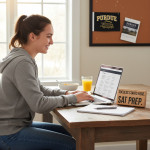Understanding Overconfidence: A Hidden Test-Day Trap
Picture this: you finish an SAT practice section, glance at your answer sheet, and feel a warm, confident glow. “I nailed that,” you tell yourself. You skip reviewing a couple of flagged items because you don’t want to second-guess the obvious. Two weeks later, the real test arrives and some of those “obvious” answers sting; you missed a question you thought was simple. What happened?
Welcome to the surprisingly common world of overconfidence. It’s not about arrogance—it’s a cognitive mismatch between how confident you feel and how accurate you actually are. For SAT students, that mismatch can mean missed scholarship opportunities, lower college options, or avoidable stress. This post walks through why overconfidence happens, how it shows up in SAT prep, and practical strategies to fix it so you can study smarter and test with quiet, accurate confidence.
Why overconfidence matters more than you think
Overconfidence affects behavior. If you consistently overestimate your mastery, you’ll allocate time poorly (skipping weak topics), underuse review, and make risky choices during the test (like guessing without eliminating options). On the flip side, underconfidence can cause unnecessary anxiety and wasted study hours. The goal is accurate self-knowledge—called calibration—so your study choices match where you actually are, not where you think you are.
The Psychology Behind Overconfidence
Several well-studied cognitive tendencies conspire to create overconfidence. Understanding them helps you spot the bias in action.
The Dunning–Kruger flavor: skill + self-awareness mismatch
The Dunning–Kruger effect describes a pattern where people with limited competence overestimate their abilities because they’re missing both the skill and the ability to evaluate that skill. In SAT terms, a student who hasn’t internalized punctuation rules or algebra fundamentals may not recognize when they’ve misunderstood a concept, so their confidence outpaces competence.
Familiarity bias and surface fluency
We often confuse familiarity with mastery. If you’ve seen a question type before—say a reading passage on a historical topic—you might feel fluent and thus confident. But surface familiarity can mask shallow understanding. A student who skim-reads passages and recognizes key words might feel confident, yet miss inference-based questions that require deeper engagement.
Selective memory and the illusion of improvement
People naturally remember successes more vividly than failures. After a streak of decent practice tests, it’s tempting to remember the big wins and forget the stubborn weak spots. That selective memory creates a rosier view of your preparedness than objective scores show.
Time pressure and premature confidence
Test settings create a strange feedback loop. Quick responses feel good; speed often equates to confidence. But quickly choosing an answer without checking alternatives—especially in close, multi-step problems—leads to errors. Overconfident students are more likely to move on too quickly, misreading a small but crucial detail.
How Overconfidence Shows Up on the SAT
Let’s translate cognitive theory into exam room behaviors. Overconfidence commonly appears in three ways:
- Skipping review: Assuming answers are correct and failing to revisit flagged or uncertain items.
- Ignoring diagnostic data: Discounting practice test feedback or average mistakes in favor of a gut feeling.
- Under-prioritizing weak topics: Spending most study time on comfortable sections and avoiding the areas that lower your score.
Realistic example: The “easy” grammar trap
Maya consistently scores well on grammar questions that test comma usage and subject-verb agreement. She feels confident about Writing and Language, so she focuses her limited prep on math, assuming grammar is airtight. On test day, a tricky modifier placement question appears—a format she hasn’t practiced carefully—and she misses it. Her confidence blinded her to a gap in practice variety.
Realistic example: The math shortcut that backfires
Jamal prides himself on mental math shortcuts. When a multi-step algebra question appears, he breezes to an answer using a trick he’s used before. He feels confident and skips checking his steps. A small sign error costs him the question. The shortcut wasn’t wrong; the unchecked application was.
Diagnosing Overconfidence: Simple Checks You Can Do Today
Calibration is measurable. Here are practical diagnostics you can run during practice tests to see if your confidence matches performance.
Confidence tagging during practice
Every time you answer a question on a practice test, add a quick confidence tag: low, medium, or high. After grading, compare accuracy across tags. If high-confidence answers are only correct 60–70% of the time (instead of closer to 90%), you have a calibration problem.
Confidence-accuracy table (example)
The table below shows an illustrative sample from a student’s full-length practice test where they tagged each question with a confidence level. Numbers are for demonstration to highlight common patterns. Use your own data for targeted changes.
| Confidence Level | Number of Questions | Correct (%) — Observed |
|---|---|---|
| High (I’m sure) | 40 | 72% |
| Medium (Pretty sure) | 30 | 63% |
| Low (Guessing/Unsure) | 30 | 45% |
Interpreting this example: high-confidence accuracy (72%) is well below the 85–95% you’d expect for honest “high” certainty. That gap is a clear signal of overconfidence and suggests the student is not checking answers or is confusing familiarity with mastery.
Pattern spotting: where errors cluster
Look beyond overall percentages. Are your high-confidence misses in one domain—like diagram-based reading questions or geometry? Narrowing the pattern shows where overconfidence is domain-specific rather than global.
Practical Strategies to Recalibrate Confidence
Recalibration isn’t about cultivating doubt; it’s about building reliable self-knowledge. These strategies are practical and actionable.
1. Confidence tagging + error logs
Combine confidence tags with an error log. For each missed question, record: question type, your confidence level, the mistake type (concept error, careless arithmetic, misread), and how to fix it. Over time, patterns become obvious and correctable.
2. Active review instead of passive re-reading
When you review wrong answers, don’t just read the explanation. Recreate the problem, explain your reasoning aloud or in writing, and solve a near-transfer problem (a different question that tests the same idea). Active processing stops the “I recognized it so I know it” illusion.
3. Spaced mixed practice for better metacognition
Block practice (doing 50 algebra questions in a row) can build fluency but may hide weaknesses. Mixed practice—juxtaposing algebra, geometry, and data analysis—forces retrieval in varied contexts and gives more accurate feedback about what you truly know.
4. Slow down: a purposeful check routine
Design a quick checking routine to use during the test: scan the answer for sign errors, re-evaluate tricky assumptions, or check that your final answer matches the question (e.g., units, direction). Pace change is not about getting slower; it’s about targeted micro-checks that catch common mistakes born of overconfidence.
5. Use calibration drills
Set aside short calibration drills: 20–30 practice questions where you must state a confidence percentage (e.g., I’m 80% sure). Track these over weeks to see an upward trend where stated confidence better matches accuracy. This trains metacognitive awareness — the capacity to think about your thinking.
6. Introduce accountability into practice
Ask a tutor, teacher, or study partner to review your flagged responses. External perspectives can catch blind spots and test whether your confidence is justified. If you’re using a service like Sparkl’s personalized tutoring, this is a natural fit: expert tutors offer 1-on-1 guidance, tailored study plans, and targeted feedback that quickly reveals calibration gaps and helps you build realistic confidence.
How Tutors and Technology Help Recalibrate
Human coaches and smart tools excel at spotting overconfidence because they provide objective feedback.
Why expert tutors matter
A good tutor doesn’t just teach content; they mirror your thought process. They point out where you skipped steps, misinterpreted a passage, or applied an inappropriate shortcut. With 1-on-1 guidance, tutors can design drills that focus on your overconfident patterns and force repeated correction until your internal gauge improves.
How AI-driven insights complement human coaching
Data tools can aggregate many practice sessions, quantify where your confidence mismatches occur, and suggest micro-lessons exactly where you need them. If you combine that with tailored human feedback—like Sparkl’s personalized tutoring offering AI-driven insights plus expert tutors and tailored study plans—you get the best of both worlds: objective metrics and human interpretation that builds durable calibration.
A 6-Week Plan to Fix Overconfidence (Week-by-Week)
This sample plan balances diagnostics, targeted practice, and metacognitive training. Adjust the schedule to fit your test date and current baseline.
| Week | Focus | Key Actions |
|---|---|---|
| 1 | Baseline & Diagnosis | Full-length practice test with confidence tagging; build an error log. |
| 2 | Targeted remediation | Daily 30–45 min mixed practice on weak areas; review errors actively. |
| 3 | Calibration drills | Short timed sets with percentage confidence estimates; compare to accuracy. |
| 4 | Check routines & pacing | Practice micro-checks; incorporate routine into timed sections. |
| 5 | Simulate test conditions | Full-length test; apply checking routine; review with a tutor or partner. |
| 6 | Refine & repeat | Follow-up calibration test; revise study focus; finalize test-day strategy. |
Example micro-routine for checking answers
- Math: Re-read the question prompt; ensure your final numeric answer matches units and sign.
- Reading: Quickly confirm that your chosen answer is grounded in the passage—point to the exact line in the text if possible.
- Writing: Read the sentence aloud in your head and listen for awkward grammar or shifts in meaning.
Exercises to Build Accurate Confidence
Here are three short exercises you can add to any study session to sharpen metacognitive awareness.
Exercise 1: The 3-minute post-question reflection
After each mini-set (10–12 questions), spend three minutes answering two questions: What made me confident about each correct answer? What led me astray on the incorrect ones? This habit trains you to link feelings of certainty to concrete evidence.
Exercise 2: Swap roles (explain your mistake to a peer)
Teach someone else why an answer was wrong. Explaining mistakes forces precision in your own thinking and reduces overreliance on intuition.
Exercise 3: Alternate-solution challenge
For a subset of problems, force yourself to find two different ways to solve them (algebraic vs. diagrammatic, or process-of-elimination vs. plug-in numbers). If both approaches agree, your confidence is more justified.
Common Objections and How to Think About Them
“I feel confident, so I must be doing fine.”
Feeling confident is useful—it’s a signal that something feels familiar. But signals are noisy. Pair your feeling with objective checks: tagged confidence vs. accuracy, error logs, and timed reviews. Over time, your internal signal will become less noisy.
“Checking slows me down.”
Smart checking doesn’t mean revisiting every answer. It means targeted micro-checks for high-value items or for problem types where your history shows lapses. That small time investment often saves points.
“I don’t have time to track everything.”
Start small: tag confidence for only the final third of a practice test, or do calibration drills twice per week. Tiny habits compound; most students see payoff after just a few weeks.
When to Get Extra Help
If your calibration remains off after several practice cycles, or if you notice persistent patterns (e.g., high-confidence misses on inference questions), a more structured intervention helps. That’s when tailored coaching—like Sparkl’s personalized tutoring—can accelerate improvement: expert tutors identify blind spots, create tailored study plans, and leverage data-driven insights to correct your calibration rapidly. Personalized human feedback often uncovers subtle reasoning errors that raw practice data alone can’t explain.
Final Thoughts: Aim for Quiet, Accurate Confidence
Confidence is not the enemy—misplaced confidence is. The SAT rewards careful thinking, accurate self-assessment, and thoughtful practice. Recalibrating your confidence takes intention: track your judgments, build deliberate review habits, and use mixed practice to reveal real weaknesses. When you pair objective data with focused, personalized help, your sense of readiness will become a reliable teammate rather than a misleading cheerleader.
Remember: smart prep isn’t about erasing confidence; it’s about making your confidence honest. Start small, track honestly, and adjust with purpose—your future self (and your score report) will thank you.




















No Comments
Leave a comment Cancel